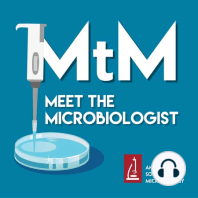24 min listen

115: 20 Years of the Lab Response Network with Julie Villanueva
115: 20 Years of the Lab Response Network with Julie Villanueva
ratings:
Length:
42 minutes
Released:
Aug 30, 2019
Format:
Podcast episode
Description
When a new biothreat or emerging infectious agent threatens, how are diagnostic protocols put into place? It’s up to the Laboratory Response Network (LRN), a multipartner network of public health, clinical and other labs, to generate and distribute reagents, and provide training to detect these threats. Julie Villanueva, Chief of the Laboratory Preparedness and Response Branch at the CDC, talks about the LRN and how no two weeks on the job are alike. Subscribe (free) on Apple Podcasts, Google Podcasts, Android, RSS, or by email. Also available on the ASM Podcast Network app. Julie’s Biggest Takeaways In the mid-1990s, the CDC joined public health representatives along with the Departments of Defense and Justice to determine the best way to prepare and respond to potential bioterrorism threats. The result was the Laboratory Response Network (LRN), founded in 1999. The LRN provides infrastructure to detect potential pathogens. Though first put into place to detect and prevent bioterror events, the LRN has also been able to detect infectious diseases that have emerged through other means. When a new disease emerges, there are typically no widely available tests to diagnose the disease. The CDC works hard to quickly develop diagnostic tests, validate the tests, manufacture the necessary reagents, and ship these out to the reference labs that are part of the LRN. This ensures that each lab can accurately reach the same result with the same sample. The laboratory response network requires more than just developing and deploying diagnostic tests. The LRN must also provide Training for LRN scientists. Proficiency testing to test the network. Reporting protocols for sending results. What diseases keep Julie up at night? A viral hemorrhagic fever is one, and microorganisms that evolve quickly and have high pathogenic potential, like influenza virus, is another. Featured Quotes “Our collaborations across other federal agencies like the FDA and the USDA are really important for us to stay on the cutting edge of what could be emerging.” “Partnerships are so critical when managing an outbreak. There’s never an outbreak that only affects one group of people...there are lots of different facets of an outbreak that need to be addressed and partnerships are critical for managing and trying to mitigate as much as possible.” “The LRN primarily focuses on diagnostics, this is what the network really does. It’s made to be able to detect biothreats and emerging infectious diseases in both clinical and environmental samples.” “We’re always looking at new technologies for faster, more sensitive, and more specific tests.” “Every outbreak has been different in a different way, and I’ve learned something every time. I think that each outbreak has taught us a few things that work well within the network and a few things with which we can improve, and continued improvement is very important to us. For example, the Ebola outbreak in 2014-16 really highlighted the need for biosafety and biosecurity procedures all across not only the network but also our hospitals...we learn something different from every outbreak.” Links for This Episode MTM Listener Survey, only takes 3 minutes. Thanks! The Laboratory Response Network(CDC website) HOM: The Origin of In Situ Hybridization- a Personal History
Released:
Aug 30, 2019
Format:
Podcast episode
Titles in the series (100)
MTS3 Ute Hentschel - Symbiotic Sea Sponges: Ute Hentshel is a professor of chemical ecology at the University of Würzburg in Germany. Her research focuses on characterizing the microbial communities associated with marine sponges, the diversity of these symbionts and their activities. On this epis by Meet the Microbiologist